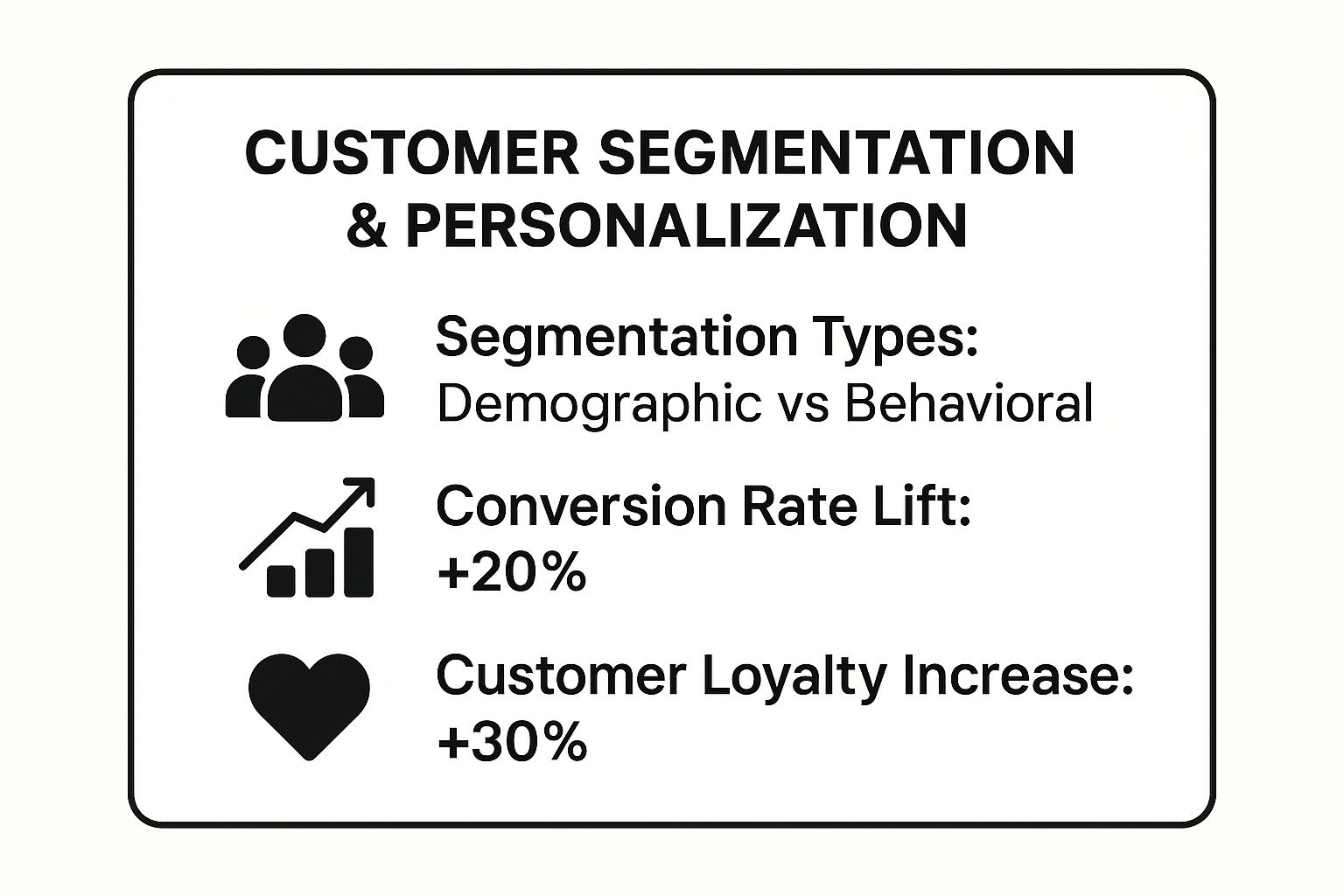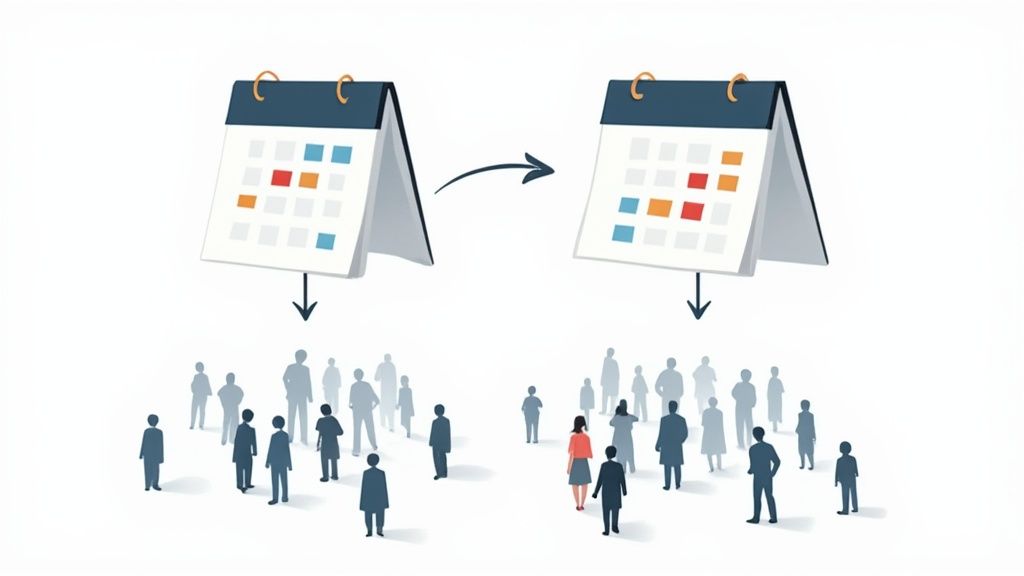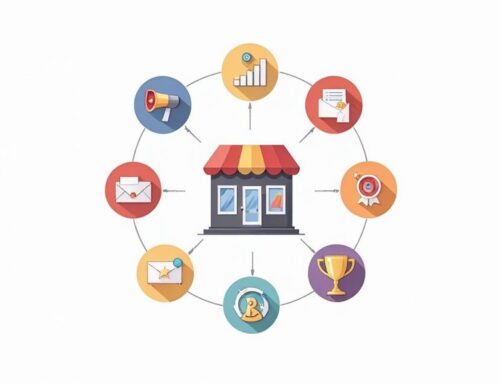In today’s competitive landscape, intuition and guesswork are no longer enough to move the needle. The most successful brands are leaning on a more powerful ally: data. By harnessing customer insights, behavioral analytics, and performance metrics, businesses can craft campaigns that resonate deeply, convert consistently, and deliver measurable ROI. But what does this look like in practice? This is where a clear plan built on data driven marketing strategies becomes essential.
This guide moves beyond theory to explore nine practical strategies that separate the leaders from the laggards. We will break down each approach into actionable steps, provide real-world examples, and recommend tools to help you implement them effectively. You will learn how to:
- Segment audiences for hyper-personalization.
- Predict future customer behavior and value.
- Optimize your budget with advanced attribution and mix modeling.
Whether you’re looking to refine customer experiences at scale or justify your marketing spend with concrete numbers, these data-powered approaches will provide a clear roadmap for success. Let’s dive into the strategies that will define marketing excellence in 2025 and beyond.
1. Customer Segmentation and Personalization
One of the most powerful data-driven marketing strategies involves moving away from a one-size-fits-all approach. Customer segmentation and personalization is the practice of dividing your audience into distinct groups based on shared characteristics. This allows you to tailor messages and experiences that resonate on a deeper, more individual level, significantly boosting engagement and conversions.
This strategy hinges on collecting and analyzing customer data, such as demographics, purchase history, and browsing behavior. By understanding who your customers are and what they value, you can create highly relevant content. For example, Netflix personalizes content recommendations for each user, while Amazon suggests products based on past views and purchases. This targeted approach makes customers feel understood, fostering loyalty and driving repeat business.
How to Implement Segmentation
Effective implementation requires a structured approach. Start by defining your goals, whether it’s increasing repeat purchases or improving email open rates, and then work backward to identify the necessary data.
- Start Simple: Begin with basic demographic or geographic segmentation. As you gather more data, you can advance to more complex behavioral or psychographic segments.
- Ensure Data Quality: Your segments are only as good as your data. Regularly clean and update your customer information to ensure accuracy and relevance.
- Test and Refine: Use A/B testing to validate your segments. Test different offers, messages, and creative on various segments to see what performs best. This iterative process is key to optimizing your data-driven marketing strategies.
To quickly grasp the core benefits, the following visual summarizes key outcomes of a well-executed personalization strategy.

As the data highlights, the impact is substantial, often leading to significant lifts in both conversion rates and long-term customer loyalty. This makes it an indispensable strategy for any business aiming for sustainable growth.
2. Predictive Analytics and Customer Lifetime Value (CLV)
Going beyond historical analysis, predictive analytics represents a forward-looking approach to data driven marketing strategies. This technique uses historical data, statistical models, and machine learning to forecast future outcomes. By predicting customer behaviors like churn risk or future purchases, marketers can proactively allocate resources, optimize retention efforts, and identify high-potential customers before their value is fully realized.
This strategy is about making smarter, proactive decisions. For example, American Express uses predictive models to detect potential fraud and anticipate customer spending patterns, offering relevant credit line increases. Similarly, Starbucks analyzes purchasing data to predict demand for specific products at certain locations, ensuring optimal inventory and staffing. Focusing on Customer Lifetime Value (CLV) allows businesses to invest more in retaining customers who are predicted to be the most profitable over time.
How to Implement Predictive Analytics
Successfully implementing predictive analytics requires a clear focus on actionable outcomes, not just complex algorithms. Start by identifying a specific business question you want to answer, such as “Which customers are most likely to churn in the next 90 days?”
- Start with Simple Models: You don’t need a team of data scientists to begin. Start with simpler predictive models like regression analysis to forecast CLV before moving to more complex machine learning algorithms.
- Combine Data Sources: For greater accuracy, integrate data from multiple sources. Combine CRM data with website analytics, social media engagement, and customer support interactions to build a holistic view.
- Focus on Actionable Predictions: The goal isn’t just accuracy; it’s about generating insights that lead to clear actions. A model that is 85% accurate and provides clear intervention steps is more valuable than a 95% accurate model that is too complex to interpret.
The power of this strategy lies in its ability to shift marketing from a reactive to a proactive function. By anticipating future trends and customer needs, you can stay ahead of the competition and cultivate more valuable long-term relationships. This makes it an essential component of modern data driven marketing strategies.
3. Marketing Attribution Modeling
Understanding which marketing efforts truly drive results is a core challenge for modern businesses. Marketing attribution modeling is a data-driven approach that analyzes and assigns value to the various touchpoints a customer interacts with on their path to conversion. This strategy allows marketers to move beyond simplistic “last-click” analysis and see the full picture of how different channels and campaigns work together to influence a final sale or lead.
This strategy hinges on tracking the complete customer journey, from the first ad they see to the final email they open before converting. By applying different models, such as linear, time-decay, or data-driven attribution, you can credit each interaction appropriately. For instance, Google Analytics 4 uses sophisticated data-driven models to show how organic search, social media, and paid ads collectively contribute to conversions, helping marketers optimize their spend and improve overall campaign performance.

How to Implement Attribution Modeling
Effective implementation requires a clear understanding of your business goals and the technical setup to capture journey data accurately. The aim is to gain a holistic view of your marketing mix’s impact.
- Choose a Model: Select an attribution model that aligns with your business objectives. A last-click model might work for short sales cycles, while a time-decay or data-driven model is better for complex, multi-touch journeys.
- Ensure Data Integrity: Implement comprehensive tracking across all channels and domains. Accurate data is the foundation of any reliable attribution model, so regularly audit your setup for gaps or inconsistencies.
- Test and Validate: Don’t just set it and forget it. Combine your attribution insights with other analyses like incrementality testing to validate the true causal impact of your campaigns. To understand the nuances of assigning credit across platforms, you can learn more about cross-channel attribution.
This methodical approach to one of the most vital data driven marketing strategies helps you justify marketing spend, allocate budgets more intelligently, and ultimately achieve a higher return on investment by focusing on what truly works.
4. Real-Time Marketing and Dynamic Content Optimization
Capitalizing on the “right now” is a cornerstone of modern data-driven marketing strategies. Real-time marketing and dynamic content optimization involve using live data streams to deliver highly relevant messages at the perfect moment. This approach leverages behavioral triggers, contextual information, and immediate data processing to create timely, personalized experiences that capture customer attention when it’s most valuable.
This strategy relies on agility and automation to react to events as they unfold. For example, Oreo’s famous “You can still dunk in the dark” tweet during the 2013 Super Bowl blackout is a classic case. Similarly, Uber’s surge pricing notifications adjust based on real-time demand, while Nike may serve ads for rain jackets to users in areas experiencing a downpour. This immediacy makes marketing feel less like an interruption and more like a helpful, timely conversation.
How to Implement Real-Time Marketing
Success in real-time marketing requires a blend of technology, clear protocols, and creative readiness. You must be prepared to act on opportunities instantly while maintaining brand consistency and quality.
- Establish Clear Protocols: Define what events trigger a real-time response and create approval workflows, especially for sensitive topics, to ensure brand safety.
- Invest in a Robust Data Infrastructure: Use tools that can process and act on data in milliseconds. This includes social listening platforms, customer data platforms (CDPs), and marketing automation systems.
- Balance Automation with Human Oversight: While automation executes the delivery, human strategists should monitor performance, refine the rules, and provide the creative spark needed for a campaign to truly resonate.
This video provides an excellent overview of how brands can leverage these immediate opportunities.
By continuously monitoring performance metrics, you can refine your approach. For a deeper dive into this, you can learn more about how to optimize campaigns in real-time on reachlabs.ai. Implementing this strategy effectively can dramatically increase engagement and conversion by meeting customers exactly where they are, at the moment they are most receptive.
5. Cohort Analysis and Customer Journey Mapping
Moving beyond individual actions, this advanced strategy groups customers into cohorts based on shared characteristics or acquisition dates. By analyzing their behavior over time and mapping their interactions across all touchpoints, marketers gain profound insights into customer retention, engagement patterns, and long-term value. This dual approach reveals not just what users do, but how their behavior evolves.
This powerful combination of data driven marketing strategies helps pinpoint exactly where and when customers drop off or thrive. For instance, Dropbox uses cohort analysis to track feature adoption among users who signed up in the same week, while Pinterest maps user journeys to optimize content discovery and engagement loops. This provides a clear, evidence-based roadmap for improving the overall customer experience and driving sustainable growth.

How to Implement Cohort Analysis and Journey Mapping
A successful implementation integrates quantitative analysis with a qualitative understanding of the customer experience. This approach requires a strategic focus on identifying meaningful patterns and turning them into actionable improvements.
- Define Meaningful Cohorts: Group users based on significant business events, such as their sign-up date, first purchase, or a specific marketing campaign they converted on. This ensures your analysis is relevant to your business goals.
- Track Key Indicators: Monitor both leading indicators (e.g., feature adoption, content views) and lagging indicators (e.g., churn rate, lifetime value) to get a complete picture of cohort health and performance over time.
- Combine Data with Empathy: Use quantitative data to identify friction points in the customer journey, then use qualitative methods like surveys or interviews to understand the “why” behind the numbers. You can find comprehensive customer journey mapping templates on reachlabs.ai to structure this process.
- Focus on Actionable Improvements: The goal is not just to map the journey but to optimize it. Prioritize fixing the bottlenecks that have the most significant negative impact on user retention and satisfaction.
By regularly updating your journey maps and analyzing new cohorts, you can create a continuously improving customer experience. This makes it an essential strategy for businesses focused on long-term loyalty and profitability.
6. Programmatic Advertising and Automated Bidding
Moving beyond manual ad buying, programmatic advertising represents a sophisticated data-driven marketing strategy that automates the purchasing of digital ad space. This algorithmic approach uses real-time data and machine learning to place bids on ad inventory, ensuring your ads are shown to the right audience at the right time and at the optimal price. It eliminates guesswork and manual negotiations, allowing for highly efficient and scalable campaigns.
This strategy relies on massive datasets to make split-second decisions about ad placements, targeting, and bidding. For instance, Google Ads’ Smart Bidding strategies automatically optimize for conversions or conversion value in every auction, a task impossible to perform manually at scale. Similarly, platforms like The Trade Desk empower major brands to reach specific audience segments across various channels, from connected TV to mobile apps, maximizing return on investment through intelligent automation.
How to Implement Programmatic Bidding
A successful programmatic strategy requires clear objectives and careful setup. It’s not a “set it and forget it” solution; it demands strategic oversight and continuous refinement to unlock its full potential.
- Define Clear Objectives: Start with a specific goal, such as increasing website traffic, generating leads, or driving sales. This goal will dictate your bidding strategy and key performance indicators (KPIs).
- Implement Robust Tracking: Accurate tracking and attribution are non-negotiable. Ensure your conversion pixels and analytics are correctly configured to feed the algorithm high-quality data for optimization.
- Refine Your Targeting: Use audience exclusions to prevent ad spend on irrelevant users or existing customers you don’t wish to target. Regularly review and optimize your audience segments based on performance data to improve efficiency.
7. A/B Testing and Multivariate Optimization
Guesswork has no place in a modern marketing campaign. A/B testing and multivariate optimization are systematic experimental approaches that remove subjectivity from the decision-making process. This strategy involves creating multiple versions of a single marketing asset, like a landing page or an email, and testing them against each other to see which one performs best. By using statistical analysis, you can definitively identify the elements that drive user action.
This is one of the most fundamental data driven marketing strategies because it provides clear, quantifiable evidence for what works. For instance, Netflix famously A/B tests its content thumbnail images to maximize click-through rates. Similarly, during the 2012 presidential campaign, Barack Obama’s team used A/B testing to optimize email subject lines and donation pages, reportedly raising an additional $60 million. This iterative process of testing and refining ensures continuous improvement and higher overall campaign ROI.
How to Implement A/B Testing
Effective implementation is about discipline and methodology. The goal is to isolate variables and measure their impact on a specific metric, such as conversion rate or engagement.
- Test One Variable at a Time: To get clear insights, change only one element between your control (version A) and your variation (version B). This could be a headline, a button color, or an image.
- Ensure Statistical Significance: Don’t end a test prematurely. Wait until you have a large enough sample size to be confident that the results aren’t due to random chance. Tools like Optimizely can help determine this.
- Document and Learn: Keep a detailed log of every test you run, including your hypothesis, the results, and your conclusions. This repository of knowledge becomes invaluable for future campaigns.
By systematically testing every critical touchpoint, you replace assumptions with hard data, turning your marketing efforts into a well-oiled optimization engine. This makes it a cornerstone strategy for any business serious about growth.
8. Marketing Mix Modeling (MMM) and Media Mix Optimization
To truly understand marketing impact on a macro level, businesses turn to Marketing Mix Modeling (MMM). This statistical analysis technique measures how various marketing tactics contribute to sales while accounting for external factors like seasonality, economic trends, and competitor actions. It provides a holistic, top-down view of your marketing effectiveness, moving beyond channel-specific metrics to reveal the true ROI of your overall strategy.
This approach is particularly powerful for large brands managing complex, multi-channel budgets. For instance, consumer goods giants like P&G and Unilever use MMM to optimize their massive global media spend, allocating funds between TV, digital, and print to achieve maximum impact. Similarly, automotive companies like General Motors analyze historical data to understand how advertising drives dealership visits and sales. These data driven marketing strategies enable marketers to justify budgets and make high-stakes allocation decisions with confidence.
How to Implement MMM
Successful implementation of MMM requires a commitment to rigorous data collection and analysis. It is not a one-time project but an ongoing process that informs strategic planning.
- Collect Historical Data: Gather at least two to three years of comprehensive historical data. This should include marketing spend and activity across all channels, sales figures, and relevant external factors.
- Incorporate External Variables: To ensure accuracy, your model must account for external influences. Include data on competitor spending, pricing changes, seasonal demand shifts, and broader economic indicators.
- Update and Validate Models: Marketing landscapes change rapidly. Regularly update your models with fresh data to maintain their relevance. Validate the results using incrementality tests to confirm the causal relationships your model suggests.
9. Customer Data Platform (CDP) Integration and Unified Customer Profiles
To truly excel at data-driven marketing strategies, businesses must break down internal data silos. The integration of a Customer Data Platform (CDP) is a foundational strategy that centralizes customer data from all touchpoints, such as your website, mobile app, CRM, and in-store systems, into a single, coherent view for each individual customer.
This unified customer profile provides a 360-degree understanding that is persistent and updated in real-time. For instance, Sephora uses a CDP to link a customer’s online browsing history with their in-store purchases, enabling highly personalized recommendations across all channels. Similarly, Starbucks leverages its rewards program data, integrated through a CDP, to power personalized offers and predict customer behavior. This complete view is the bedrock for advanced segmentation, predictive analytics, and consistent cross-channel campaigns.
How to Implement a CDP Strategy
A successful CDP implementation requires careful planning and a clear vision. The goal is to create a single source of truth for all customer-related data that is accessible and actionable for marketing teams.
- Establish Strong Governance: Before you begin, define clear data governance policies. Decide what data to collect, how it will be standardized, who can access it, and how it will be used to ensure consistency and compliance.
- Prioritize Data Quality: A CDP is only as effective as the data it contains. Focus on integrating high-quality, relevant data sources first. Regularly clean and validate your data to maintain the integrity of your unified profiles.
- Plan for Scalability and Compliance: Choose a platform that can grow with your business and ensure it helps you comply with privacy regulations like GDPR and CCPA from day one. This proactive approach prevents future roadblocks and legal issues.
9 Data-Driven Marketing Strategies Comparison
| Strategy | Implementation Complexity (🔄) | Resource Requirements (⚡) | Expected Outcomes (⭐📊) | Ideal Use Cases (💡) | Key Advantages (⭐) |
|---|---|---|---|---|---|
| Customer Segmentation and Personalization | Medium to High: data collection & management | High: data infrastructure & privacy compliance | Increased engagement, conversion, loyalty (+20-30%) | Targeted campaigns, personalized experiences | Better ROI, improved customer lifetime value |
| Predictive Analytics and CLV | High: advanced analytics expertise required | High: data quality, model maintenance | Proactive retention, optimized spend, competitive advantage | Forecasting churn, acquisition, strategic decisions | Foresight-driven resource allocation |
| Marketing Attribution Modeling | High: complex setup & data integration | Medium to High: technical and integration needs | Clear marketing ROI, budget optimization | Multi-channel campaign analysis | Data-driven budget allocation, improved campaign efficacy |
| Real-Time Marketing & Dynamic Content | Very High: complex infrastructure | Very High: real-time data processing & automation | Higher engagement & conversion via timely content | Time-sensitive, behavior-triggered marketing | Enhanced brand responsiveness, competitive speed |
| Cohort Analysis & Customer Journey Mapping | Medium to High: data intensive & complex analysis | Medium: extensive data tracking and updates | Insight into retention, behavior evolution | Customer retention, journey optimization | Clear retention patterns, friction identification |
| Programmatic Advertising & Automated Bidding | High: algorithmic setup & ongoing management | Medium to High: data and monitoring systems | Efficient bidding, targeting, cost optimization | Automated ad buying, real-time bidding | Scalable, precise targeting with reduced manual work |
| A/B Testing & Multivariate Optimization | Medium: manageable but needs traffic & stats | Low to Medium: requires testing tools and traffic | Continuous performance improvement, data-driven wins | Conversion optimization, campaign testing | Risk reduction, elimination of guesswork |
| Marketing Mix Modeling (MMM) & Media Mix | Very High: complex statistical modeling | High: extensive historical data, analytics | Holistic channel impact, optimized budget | Strategic long-term planning, cross-channel budgeting | Comprehensive ROI view, accounts for external factors |
| Customer Data Platform (CDP) Integration | Very High: system integration & governance | Very High: infrastructure & ongoing maintenance | Unified customer profiles, improved personalization | Centralized data for cross-channel marketing | Single source of truth, enhanced marketing efficiency |
Turning Data into Your Greatest Marketing Asset
The journey from traditional, instinct-based marketing to a data-centric powerhouse is a transformational one. As we’ve explored, the landscape of data driven marketing strategies is not about a single magic bullet, but rather a sophisticated toolkit designed to bring clarity and precision to every campaign. The nine strategies detailed in this guide, from hyper-personalizing customer experiences with advanced segmentation to optimizing your entire budget with marketing mix modeling, represent the new frontier of effective marketing.
The common thread weaving through each of these approaches is the fundamental shift from assumption to evidence. Instead of guessing what customers want, you can know. Instead of hoping a campaign will resonate, you can predict its impact. This is the core value proposition of data-driven marketing: it replaces ambiguity with actionable intelligence, empowering you to make smarter, faster, and more profitable decisions.
From Insights to Impact: Your Action Plan
Mastering these strategies is an ongoing process, not a one-time project. It requires a commitment to building a culture of curiosity and continuous improvement. To begin turning these concepts into tangible results, consider the following steps:
- Start Small, Scale Smart: You don’t need to implement all nine strategies at once. Begin with the one that addresses your most pressing business challenge. Is customer retention a problem? Focus on cohort analysis and CLV prediction. Is your ad spend a black box? Start with attribution modeling or A/B testing your creatives.
- Unify Your Data Foundation: The effectiveness of every strategy, especially personalization and journey mapping, hinges on a clean, unified view of your customer. Prioritizing the integration of your data sources into a Customer Data Platform (CDP) is a foundational step that will pay dividends across all your marketing efforts.
- Invest in the Right Tools and Talent: Technology is the engine of data-driven marketing, but people are the drivers. Assess your current martech stack and identify gaps. Simultaneously, invest in training your team or partnering with experts who can translate complex data into clear, strategic actions.
Embracing this data-first mindset does more than just boost ROI; it fundamentally changes your relationship with your audience. You move from broadcasting messages to engaging in meaningful, relevant conversations at scale. By leveraging data driven marketing strategies, you build a resilient, adaptive, and customer-obsessed organization poised for sustainable growth in an increasingly competitive world. The future of marketing is not about having the most data, but about being the best at using it to create value.
Ready to unlock the full potential of your marketing data but not sure where to start? The team at ReachLabs.ai specializes in implementing the advanced data driven marketing strategies discussed in this article, from predictive analytics to full-funnel attribution. Visit ReachLabs.ai to see how our expertise can help you build a smarter, more profitable marketing engine.





